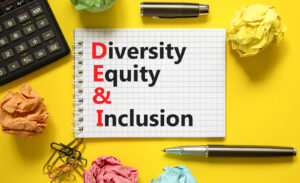
Considering the development of a DEI training program? There are many valid reasons to develop a training program to address your approach to Diversity, Equity, and Inclusion (DEI). The rationale often is:
-
- DEI fosters creativity, fresh perspectives, and understanding in collaboration, team-building, and problem-solving.
- DEI enables organizations to be more inclusive of different ideas, cultures, and lifestyles, leading to improved company culture.
- When a variety of points of view are accepted and encouraged, there can be a greater readiness to innovate.
- DEI initiatives can lead to an increased ability to recruit or expand a diverse talent pool.
- DEI initiatives often lead to higher employee retention, with some statistics reflecting it can be as much as 5.4 times higher (source: Great Place to Work)
- DEI efforts can enhance corporate branding, and potentially higher revenue.
DEI training programs are often designed to build awareness of DEI concepts, develop skillsets that promote DEI principles, or develop leaders that embody DEI principles. All are worthy programmatic goals. So why are DEI training programs not always effective when it comes to moving the needle on DEI initiatives?
The commitment to a diverse, equitable, and inclusive environment where all employees feel respected, a sense of belonging, and able to speak from their own lived experience is everyone’s responsibility. Before developing a DEI training program consider the bigger picture of DEI within your organization. Make sure that your people, your greatest asset, are truly supported by the authenticity of your organization’s DEI strategy, goals, and roadmap.
For example, when observing Pride month, celebrating the achievements, contributions, and support of LGBTQ+ employees, partners, and customers, consider the following:
-
- Does your organization have and use a set of codified DEI definitions in your organization? Do these definitions seek to instill acceptance for all employees regardless of sexual orientation or gender identification?
- Do your current organizational training programs protect the rights of all your employees in the way they participate in training, the transparency of classroom discussion, and the examples used in training scenarios?
- Do your organization’s employee policies and benefit programs provide equitable treatment to all employees regardless of sexual orientation or gender identification?
DEI should be so much more than just prescribed training. It requires alignment of your DEI strategy to organizational culture and values, leadership support, and understanding of DEI in general. Join me for Part 2 of this blog coming soon.
Holly Young is a Partner at PeopleResults. You can reach her at hyoung@people-results.com or follow her on LinkedIn.




